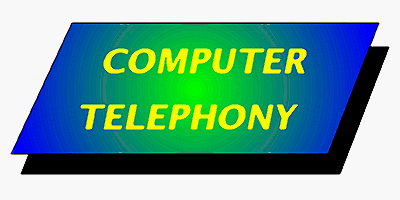

|
|

Computer Telephony Computer Telephony (CT) is a new technology providing common users with a wide spectrum of computer-based or computer-aided services through public telephones. Computers equipped with special hardware play roles of intelligent telephone exchanges (PBXs), which can switch incoming calls as well as interact with the user. CT applications can play messages or other audio files - previously recorded or synthesized on the fly. A person on the other end can press buttons or even speak if the application is able to analyze human speech. Simple as it is, this model of communication can be quite efficient. The technology is a perfect solution wherever one needs to answer a lot of calls every day, and the disliked Please leave a message is not enough. On the other hand, computer programs in CT can be completely invisible to users. They just switch calls and let people talk. The essential issue here is that the software takes care of the switching so that no human help is necessary in general. The advantages of CT are the ease of use and high availability of telephones together with the flexibility of computers. While Internet gives a better and more universal access to information and services, it is still easier to grab your cellular phone and call the airport to make a reservation than to find a computer and do the same with a browser, especially if you are just driving your car. CT allowes people do more - and often quicker - with the same phones as they have known and used for years.
Although quite innovative, Computer Telephony has
already been tested in various commercial
applications, e.g. call centers, call switching
systems, answering machines.
Among other CT vendors are Pika Technologies Inc. and
Ericsson. Pika produces CT boards, while Ericsson
offers a variety of products, ranging from telephone exchanges to complete hardware and
software applications.
Another interesting idea is IP-Telephony. This application uses existing IP networks to transmit voice data from and to the public telephone network. This gives us a possibility to talk to somebody if we have a computer capable of playing and recording sound, and networked, of course. It can also be more economical than the public telephone network, especially if we have a long-distance Internet connection. Being aware of the variety of hardware solutions present at the CT market, we decided to design a programming library that provides an abstract, object-oriented and hardware-independent API. By using it, programmers can be sure that their code will work with different CT boards or even a PBX. We are also trying to integrate computer telephony with our ABng system. Generally, the aim is to use ABng to find the phone to which the incoming call should be switched. In most cases it will be the phone nearest to the person who should answer the call.
Last but not least, we want to build a call center. This is a very popular application
and very interesting from the designer's point of view. This system can be used in places
where one needs to answer a lot of calls. The task of the software is to assign an
incoming call to a proper person (called agent) and to switch it there.
|